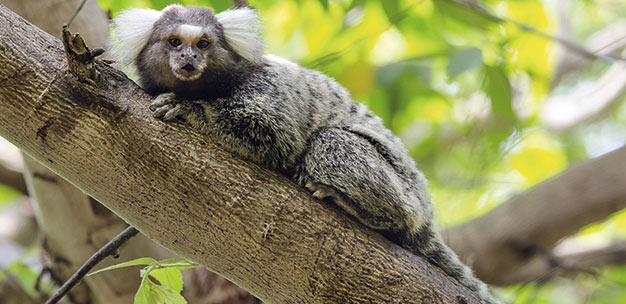Marmosets that express introduced genes and pass them on to their offspring are invaluable for understanding, and potentially treating, human disorders
Published online 6 March 2015

The common marmoset is an ideal model animal for understanding human disease.
© gracethang/iStock/Thinkstock
Like humans, marmoset monkeys (Callithrix jacchus) are raised by their families. Infants clutch the furry backs of their parents and elder siblings, who also forage to feed them. Group members communicate through direct eye contact and audible calls, taking breaks to listen to each other. "These are highly social behaviors," says Hideyuki Okano, dean of the Graduate School of Medicine at Keio University, "which makes the common marmoset an excellent model for studying human psychiatric disorders such as autism and schizophrenia."
Unlike the brains of mice ― the model animal most commonly used in research ― marmoset brains contain regions essential for higher cognitive functions, Okano explains. Marmosets are New-World natives and valuable candidates for biomedical research due to several practical reasons: they reach sexual maturity shortly after their first birthday, females can produce between 40 and 80 offspring during their lifetime, and the species is smaller and gentler overall. "A cat is much easier to handle than a lion, isn't it?" says Okano for comparison.
But to exploit these attractive attributes for research, scientists needed to develop marmosets capable of expressing foreign genes and bequeathing them to their offspring. Erika Sasaki's laboratory at the Central Institute for Experimental Animals and Okano's laboratory at Keio University attempted this challenge in early 2006.
They injected a virus carrying a gene for green fluorescent protein (GFP) directly into fertilized marmoset eggs using what Okano describes as a "cheap trick ― scientists a century ago could have come up with the idea." They dipped the fertilized eggs in a sucrose solution, which caused the cytoplasm to shrink, tearing the cell membrane away from the extracellular coating called the zona pellucida. The researchers were then able to inject many of their virus particles into the expanded interstitial zone known as the perivitelline space. The visible green fluorescence of the expressed transgenes allowed them to easily screen candidate embryos up until their transfer into surrogate mothers.
After 144 days of gestation, four transgenic founder marmosets were born with patches of green hair and skin. The researchers waited a year for the animals to reach sexual maturity and then inseminated a normal egg with a sperm from one of the transgenic males. After another transfer to a surrogate mother and another 144 days, an infant marmoset with green skin and the GFP-transgene in its genome was born. The study, published in Nature in 2009, represented the first report of a transgenic non-human primate with germline transmission1.
Marmoset research has since expanded exponentially and could soon lead to therapies for as-yet-incurable human disorders. Proving the superiority of the primate for research, Okano's lab recently found that a marmoset model of an immunological disease captured human pathophysiology much better than mouse models do. Marmosets will also play a central role in a ten-year national project launched in June 2014, for which Okano's laboratory is mapping the structure and function of the marmoset brain, including models for diseases such as Alzheimer's and Parkinson's. The laboratory is also separately screening drugs using induced pluripotent stem cells derived from patients with these diseases and plans to test any promising compounds on their disease models. Okano is hopeful: "In this way, we can identify new drugs that work to cure these diseases."
Reference
1. Sasaki, E. et al. Generation of transgenic non-human primates with germline transmission. Nature 459, 523-527 (2009). | article